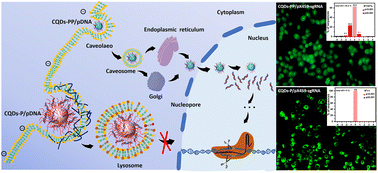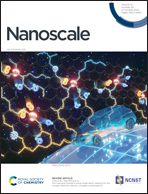Nuclear-targeted carbon quantum dot mediated CRISPR/Cas9 delivery for fluorescence visualization and efficient editing†
Abstract
Nuclear targeted delivery has great potential in improving the efficiency of non-viral carrier mediated genome editing. However, direct and efficient delivery of CRISPR/Cas9 plasmid into the nucleus remains a challenge. In this study, a nuclear targeted gene delivery platform based on fluorescent carbon quantum dots (CQDs) was developed. Polyethylenimine (PEI) and polyethylene glycol (PEG) synergistically passivated the surface of CQDs, providing an excitation-independent green-emitting fluorescent CQDs–PEI–PEG conjugate (CQDs–PP) with an ultra-small size and positive surface charge. Here we show that CQDs–PP could bind CRISPR/Cas9 plasmid to form a nano-complex by electrostatic attraction, which can bypass lysosomes and enter the nucleus by passive diffusion, and thereby improve the transfection efficiency. Also, CQDs–PP could deliver CRISPR/Cas9 plasmid into HeLa cells, resulting in the insertion/deletion mutation of the target EFHD1 gene. More importantly, CQDs–PP exhibited a considerably higher gene editing efficiency as well as comparable or lower cytotoxicity relative to Lipo2000 and PEI-passivated CQDs–PEI (CQDs–P). Thus, the nuclear-targeted CQDs–PP is expected to constitute an efficient CRISPR/Cas9 delivery carrier in vitro with imaging-trackable ability.



 Please wait while we load your content...
Please wait while we load your content...